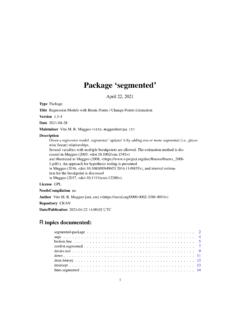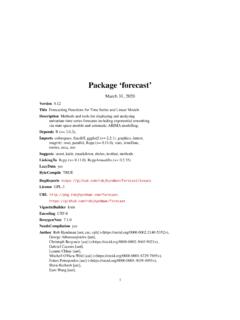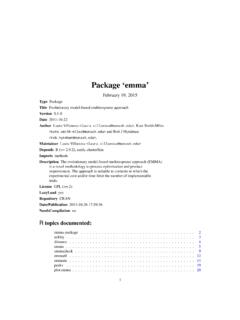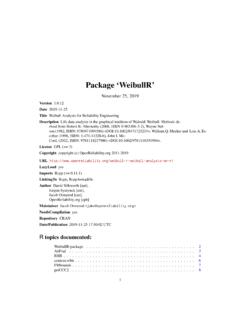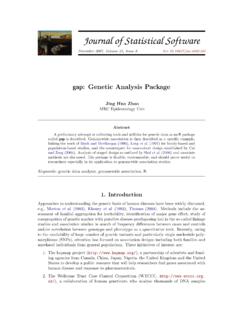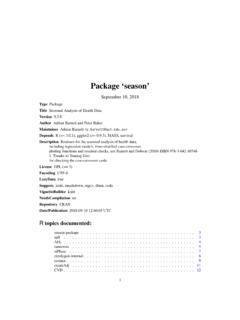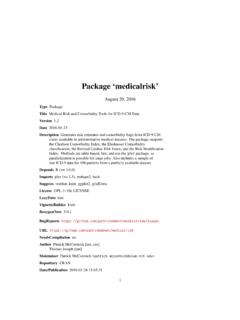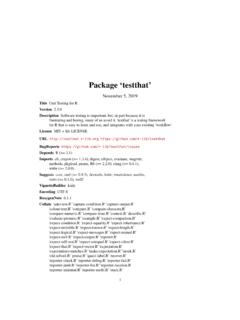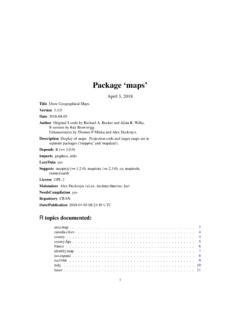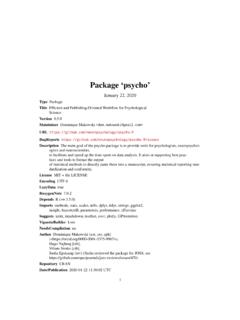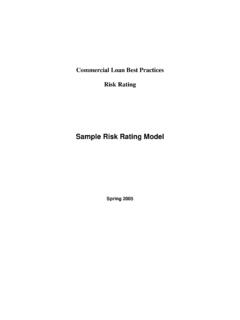Transcription of Guide to Credit Scoring in R
1 Credit Scoring in R 1 of 45. Guide to Credit Scoring in R. By DS (Interdisciplinary Independent Scholar with 9+ years experience in risk management). Summary To date Sept 23 2009, as Ross Gayler has pointed out, there is no Guide or documentation on Credit Scoring using R (Gayler, 2008). This document is the first Guide to Credit Scoring using the R system. This is a brief practical Guide based on experience showing how to do common Credit Scoring development and validation using R. In addition the paper highlights cutting edge algorithms available in R and not in other commercial packages and discusses an approach to improving existing Credit scorecards using the Random Forest package. Note: This is not meant to be tutorial on basic R or the benefits of it necessarily as other documentation for does a good job for introductory R.
2 Acknlowedgements: Thanks to Ross Gayler for the idea and generous and detailed feedback. Thanks also to Carolin Strobl for her help on unbiased random forest variable and party package. Thanks also to George Overstreet and Peter Beling for helpful discussions and guidance. Also much thanks to Jorge Velez and other people on R-help who helped with coding and R solutions. Credit Scoring in R 2 of 45. Table of Contents Approach to Model Architectural Practical R Code Reading Data Binning Example of Binning or Coarse Classifying in R:..4. Breaking Data into Training and Test Traditional Credit Traditional Credit Scoring Using Logistic Regression in Calculating ROC Curve for Calculating KS Calculating top 3 variables affecting Credit Score Function in Cutting Edge techniques Available in Using Bayesian N Using Traditional recursive Comparing Complexity and out of Sample Compare ROC Performance of Converting Trees to Bayesian Networks in Credit Using Traditional recursive Comparing Complexity and out of Sample Compare ROC Performance of Converting Trees to Conditional inference Trees.
3 18. Using Random Calculating Area under the Cross Validation ..26. Cutting Edge techniques: Party Package(Unbiased Non parametric methods-Model Based Trees)..26. Appendix of Useful ..34. Appendix: German Credit Credit Scoring in R 3 of 45. Goals The goal of this Guide to show basic Credit Scoring computations in R using simple code. Approach to Model Building It is suggested that Credit Scoring practitioners adopt a systems approach to model development and maintenance. From this point of view one can use the SOAR. methodology, developed by Don Brown at UVA (Brown, 2005). The SOAR process comprises of understanding the goal of the system being developed and specifying it in clear terms along with a clear understanding and specification of the data, observing the data, analyzing the data, and the making recommendations (2005).
4 For references on the traditional Credit Scoring development process like Lewis, Siddiqi, or Anderson please see Ross Gayler's Credit Scoring references page ( ). Architectural Suggestions Clearly in the commercial statistical computing world SAS is the industry leading product to date. This is partly due to the vast amount of legacy code already in existence in corporations and also because of its memory management and data manipulation capabilities. R in contrast to SAS offers open source support, along with cutting edge algorithms, and facilities. To successfully use R in a large scale industrial environment it is important to run it on large scale computers where memory is plentiful as R, unlike SAS, loads all data into memory. Windows has a 2 gigbayte memory limit which can be problematic for super large data sets.
5 Although SAS is used in many companies as a one stop shop, most statistical departments would benefit in the long run by separating all data manipulation to the database layer (using SQL) which leaves only statistical computing to be performed. Once these 2 functions are decoupled it becomes clear R offers a lot in terms of robust statistical software. Practical Suggestions Building high performing models requires skill, ability to conceptualize and understand data relationships, some theory. It is helpful to be versed in the appropriate literature, brainstorm relationships that should exist in the data, and test them out. This is an ad hoc process I have used and found to be effective. For formal methods like Geschka's brainwriting and Zwicky's morphological box see Gibson's Guide to Systems analysis (Gibson etal, 2004).
6 For the advantages of R and introductory tutorials see Credit Scoring in R 4 of 45. R Code Examples In the Credit Scoring examples below the German Credit Data set is used (Asuncion et al, 2007). It has 300 bad loans and 700 good loans and is a better data set than other open Credit data as it is performance based vs. modeling the decision to grant a loan or not. The bad loans did not pay as intended. It is common in Credit Scoring to classify bad accounts as those which have ever had a 60 day delinquency or worse (in mortgage loans often 90 day plus is often used). Reading Data In # read comma separated file into memory data< ("C:/Documents and Settings/My "). Binning Example In R dummy data variables are called factors and numeric or double are numeric types.
7 #code to convert variable to factor data$ property < (data$ property). #code to convert to numeric data$age < (data$age). #code to convert to decimal data$amount< (data$amount). Often in Credit Scoring it is recommended that continuous variables like Loan to Value ratios, expense ratios, and other continuous variables be converted to dummy variables to improve performance (Mays, 2000). Example of Binning or Coarse Classifying in R: data$amount< (ifelse(data$amount<=2500,'0- 2500',ifelse(data$amount<=5000,'2600-500 0','5000+'))). Note: Having a variable in both continuous and binned (discrete form) can result in unstable or poorer performing results. Breaking Data into Training and Test Sample The following code creates a training data set comprised of randomly selected 60% of the data and the out of sample test sample being a random 40% sample remaining.
8 Credit Scoring in R 5 of 45. d = sort(sample(nrow(data), nrow(data)*.6)). #select training sample train<-data[d,]. test<-data[-d,]. train<-subset(train,select=-default). Traditional Credit Scoring Traditional Credit Scoring Using Logistic Regression in R. m<-glm(good_bad~.,data=train,family=bino mial()). # for those interested in the step function one can use m<- step(m) for it # I recommend against step due to well known issues with it choosing the optimal #variables out of sample Calculating ROC Curve for model There is a strong literature based showing that the most optimal Credit Scoring cut off decisions can be made using ROC curves which plot the business implications of both the true positive rate of the model vs. false positive rate for each score cut off point (Beling et al, 2005).
9 #load library library(ROCR). #score test data set test$score<-predict(m,type='response',te st). pred<-prediction(test$score,test$good_ba d). perf <- performance(pred,"tpr","fpr"). plot(perf). For documentation on ROCR see Sing (Sing etal, 2005). Calculating KS Statistic To the dismay of optimal Credit Scoring cut off decision literature the KS statistic is heavily in use of the industry. Hand has shown that KS can be misleading and the only metric which matters should be the conditional bad rate given the loan is approved (Hand, 2005). That said due to prevalence of KS we show how to compute it in R as it might be needed in work settings. The efficient frontier trade off approach although optimal seems to not Credit Scoring in R 6 of 45.
10 Appeal to executives as making explicit and forced trade offs seems to cause cognitive dissonance. For some reason people in the industry are entrenched on showing 1 number to communicate models whether it is KS or FICO etc. #this code builds on ROCR library by taking the max delt #between cumulative bad and good rates being plotted by #ROCR. max(attr(perf,' ')[[1]]-attr(perf,' ')[[1]]). KS is the maximum difference between the cumulative true positive and cumulative false positive rate. The code above calculates this using the ROC curve. If you do not use this cut off point the KS in essence does not mean much for actual separation of the cut off chosen for the Credit granting decision. Calculating top 3 variables affecting Credit Score Function in R.
